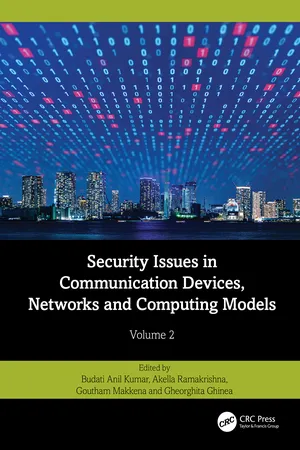
Security Issues in Communication Devices, Networks and Computing Models
Volume 2
- 264 pages
- English
- ePUB (mobile friendly)
- Available on iOS & Android
Security Issues in Communication Devices, Networks and Computing Models
Volume 2
About this book
The importance of addressing security issues in communication devices, networks, and computing models in Industry 5.0 cannot be overstated. Industry 5.0 represents the next phase in the evolution of manufacturing and industrial processes, characterized by increased connectivity, automation, and the integration of smart technologies. Here are several reasons why security is crucial in this context: Industry 5.0 involves the convergence of information technology (IT) and operational technology (OT), making industrial control systems susceptible to cyber threats. A breach in security could compromise critical infrastructure such as power grids, transportation systems, and water treatment plants. Securing computing models and networks is vital for protecting critical infrastructure and ensuring the safety and stability of essential services.
Industry 5.0 encourages the use of advanced technologies such as the Industrial Internet of Things (IIoT) and edge computing, leading to increased data exchange and collaboration. Security issues could result in the theft or manipulation of intellectual property, proprietary designs, and sensitive business information. Robust security measures are necessary to safeguard intellectual property, maintain a competitive edge, and foster innovation within Industry 5.0 ecosystems. Communication devices and networks in Industry 5.0 transmit vast amounts of sensitive data, including production data, supply chain information, and operational metrics. Ensuring the integrity and confidentiality of this data is crucial for informed decision-making and maintaining a competitive advantage. Security breaches could lead to data manipulation, unauthorized access, and exposure of sensitive information, jeopardizing the trust of stakeholders and partners. Industry 5.0 involves interconnected supply chains, where multiple entities collaborate and share data. Weaknesses in communication devices and networks can be exploited to compromise the integrity of the entire supply chain, impacting product quality and safety. Securing communication channels and computing models is vital for maintaining the trustworthiness of the supply chain, ensuring product quality, and minimizing the risk of counterfeit components.
In summary, addressing security issues in communication devices, networks, and computing models is fundamental to the successful implementation of Industry 5.0. It not only protects the assets and operations of organizations but also contributes to the overall safety, reliability, and sustainability of advanced industrial systems.
Frequently asked questions
- Essential is ideal for learners and professionals who enjoy exploring a wide range of subjects. Access the Essential Library with 800,000+ trusted titles and best-sellers across business, personal growth, and the humanities. Includes unlimited reading time and Standard Read Aloud voice.
- Complete: Perfect for advanced learners and researchers needing full, unrestricted access. Unlock 1.4M+ books across hundreds of subjects, including academic and specialized titles. The Complete Plan also includes advanced features like Premium Read Aloud and Research Assistant.
Please note we cannot support devices running on iOS 13 and Android 7 or earlier. Learn more about using the app.
Information
Table of contents
- Cover Page
- Half Title page
- Title Page
- Copyright Page
- Contents
- About the Editors
- Contributors
- Chapter 1 Effect of different vehicles’ speed on QoS performance metrics and WAVE metrics on OLSR VANET routing protocol
- Chapter 2 Equitable edge coloring of unionized triangular patterns in graphs
- Chapter 3 IoT-based development of smart building applications
- Chapter 4 Secure biometric authentication of E-Passport system
- Chapter 5 Efficient scalable binary counter using low-complexity sorting networks for VLSI applications
- Chapter 6 Convolutional neural networks: Based EEG signal fervor identification
- Chapter 7 LSTM-based cloud workload prediction using PSO-GA hybrid algorithm
- Chapter 8 An improved noise filter design for Canny edge detection with pipeline architecture
- Chapter 9 FPGA implementation of 256-bit Key AES algorithm using a modified S-box sharing algorithm
- Chapter 10 Design and implementation of LPG gas cylinder management and alerting system using IoT
- Chapter 11 A machine learning approach for sentiment analysis of Hindi tweets
- Chapter 12 Detection of Alzheimer’s disease using deep learning MobileNet model
- Chapter 13 Leveraging machine learning and web applications for heart disease prediction
- Chapter 14 Smart food donation: An Android app for efficient waste management
- Chapter 15 Counterfeit products detection using blockchain technology
- Chapter 16 Advanced deep learning framework for accurate analysis of benign and malignant skin cancer
- Chapter 17 Revolutionizing healthcare with smart syringe pump: Design and implementation
- Chapter 18 Advanced lung cancer detection using EfficientDet: A deep learning approach
- Chapter 19 EffiCoNet: A hybrid approach to colon cancer detection using EfficientNet
- Chapter 20 CerviYOLO: Advanced cervical cancer detection using YOLOv5
- Chapter 21 Deep learning models for accurate identification of mammographic abnormalities
- Chapter 22 Sign language detection and recognition using machine learning (ML) architectures
- Index